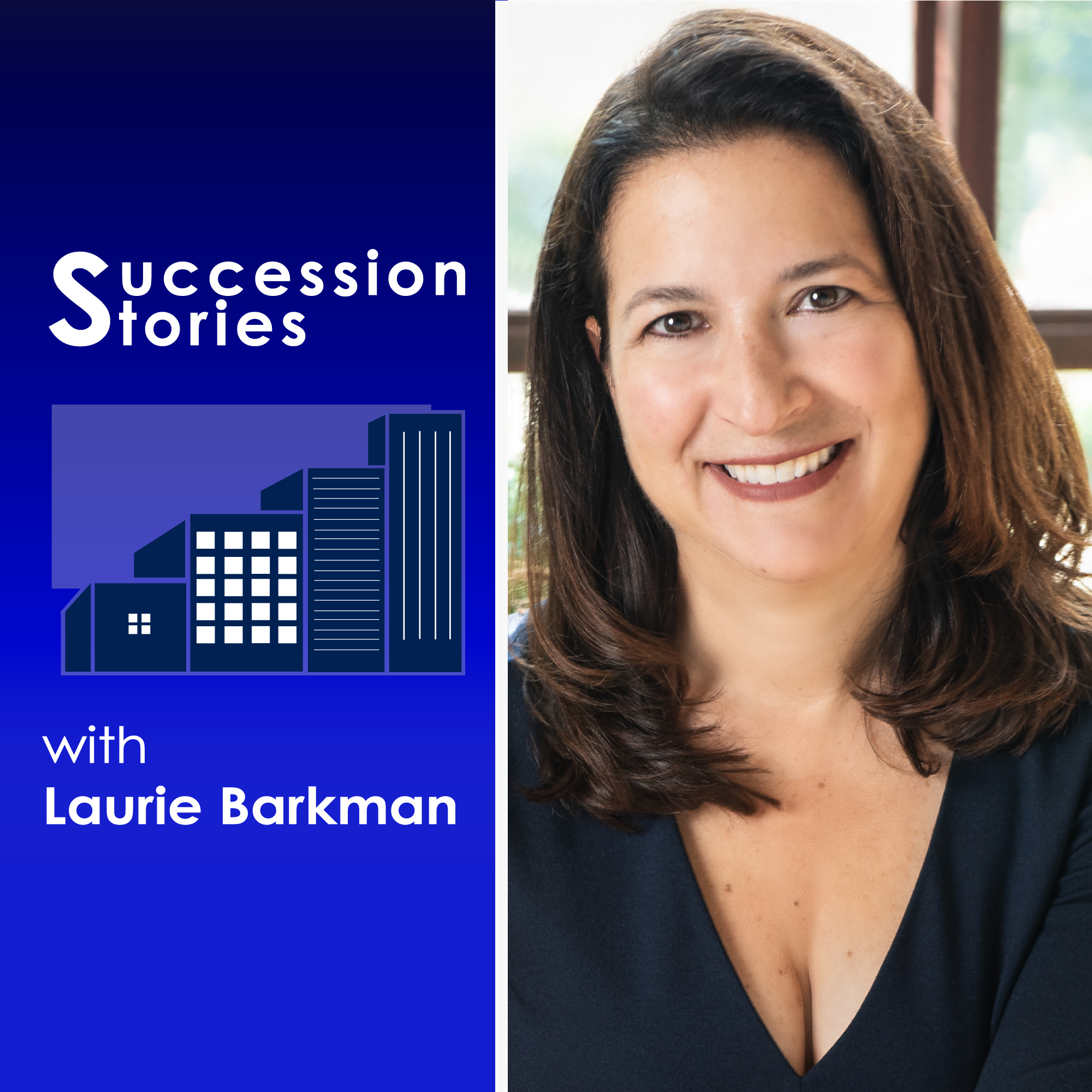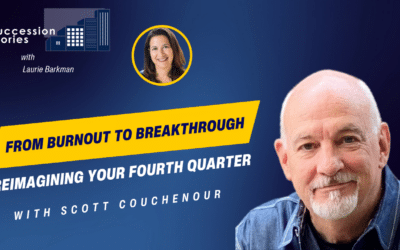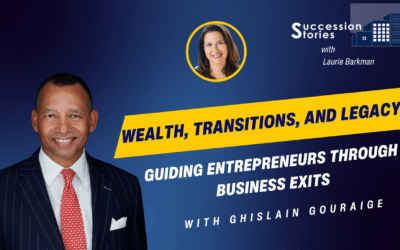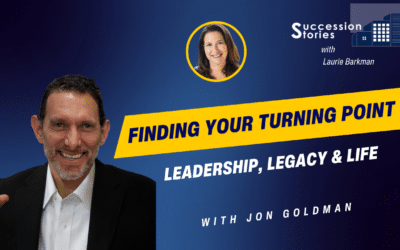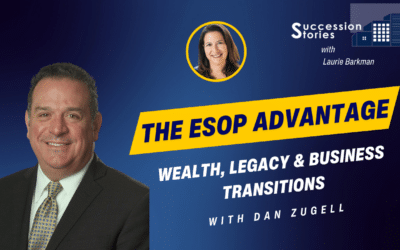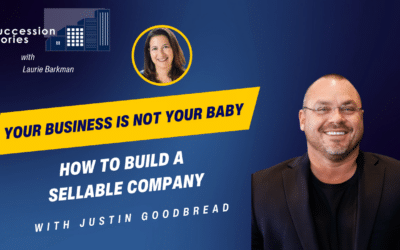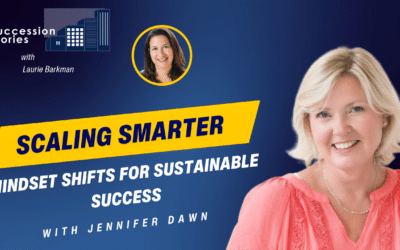Catch up on the Succession Stories Podcast with highlights from recent episodes. Host Laurie Barkman spotlights the challenges of business transition, M&A exits, and succession in this special Rewind episode. Topics include building a more sellable business with Jeffrey Feldberg, how to value a business with Fred Kaplan and Kristi Poszlusny, and spotting hidden risk factors in business transferability with Rebecca Monet.
Whether you’re a long-time listener or new to the show, subscribe to Succession Stories in your favorite podcast player, and on YouTube, so you don’t miss any episodes. You can always go back and listen to earlier shows in the catalog. Enjoy today’s Rewind episode of Succession Stories.
Show Links:
Succession Stories E105
Succession Stories E104
Succession Stories E107
About Succession Stories Podcast
Succession Stories is an award-winning podcast hosted by Laurie Barkman, The Business Transition Sherpa– guiding business owners through the process from “transition to transaction.” Subscribe to Succession Stories and share a review if you enjoy the show!
Learn more at https://thebusinesstransitionsherpa.com
Book a 1:1 Advisory call at: www.meetlauriebarkman.com
_______________________________________
Become an Official Patron of Succession Stories Podcast:
https://www.patreon.com/lauriebarkman
Don’t leave your exit to chance.
Stony Hill Advisors works with owners like you to get ready and maximize value when you’re ready to sell.
Visit www.stonyhilladvisors.com/podcast for a complimentary business valuation.
Transcript
Welcome to the Succession Stories Rewind highlighting a few of my favorite clips from recent episodes. This show guides entrepreneurs, next generation leaders, and business owners how to approach the challenges of business transition, M&A exits, and succession. Listen in as I talk with my guests about how to build a more sellable business and ways to avoid transition pitfalls. If you’d like to talk about your business transition, I’d love to meet you. Visit meetlauriebarkman.com to schedule a call. Whether you’re a long-time listener or new to the show, subscribe to Succession Stories in your favorite podcast player, and on YouTube, so you don’t miss any episodes. You can always go back and listen to earlier shows in the catalog. I hope you enjoy today’s Rewind episode of Succession Stories.
Laurie Barkman:
My conversation with Jeffrey Feldberg, co-founder of the Deep Wealth Experience, hit so many high notes it was challenging for me to choose just a few clips. A key question underlying this episode is how do you master something you’ve never done before, like selling your business? Jeffrey and his partners founded Embanet, an e-learning company, and when the time came to sell, they rejected a seven-figure offer. Two years later, they sold for nine figures. Jeffrey shares insights on this remarkable achievement and how having an excellent team of trusted advisors helped maximize his business value. This clip focuses on the realization that the skills used to start your business won’t be the ones used to sell it. If you haven’t heard the full episode yet, or want to catch all of the entrepreneurial exit planning wisdom drops again, give E105 a listen.
Jeffrey Feldberg:
Laurie, we were just so inexperienced at that time as successful as company were. We were inexperienced, the potential buyer saw that. The best thing we could have done would have been to hire someone like yourself and get professional representation and you would have gone right away, “Jeffrey, why are you wasting your time with this? Let’s forget it. You know, let me work my magic. I’ll put together a competitive bid for you and we’ll really see what the company can do. But let me help you along the way to do a few things before you get there.” But no. It was just ourselves dealing with this one buyer. Unsolicited offers are the worst thing that can happen. They’re not the best thing. There’s a reason that buyers love unsolicited offers.
Laurie Barkman:
Buyers like to get proprietary deals. It’s hard. I think if we take an objective look at both sides sometimes it can be a win because sellers don’t have the time or energy to run a process themselves. Let’s talk about your process. You said no to the unsolicited offer, a couple of years go by, and then what’s happening? What did you do in those years in between to prepare the company to sell?
Jeffrey Feldberg:
What’s interesting about the entrepreneurial journey is if we do it, we can take what some people would say is your biggest loss, and turn that into your biggest win. When we said no to the seven figure offer, we said yes to mastering the art and science of a liquidity event and we learned a lot about where our company wasn’t. Because we saw what the buyer saw, we saw all the shortcomings.
Now in our mind, we knew what the company could do, we just didn’t have the right way of sharing that narrative or being able to show the results and so we reverse engineer the process and we said, “Okay, based on what the buyer went through, based on all as we now call them, today, a deep all the skeletons in the closet that the buyer was only too happy to put in our faces. Let’s deal with those. And let’s find all the other ones that weren’t found. And let’s knock them off one by one by one. But let’s also speak to other people who have good intentions who don’t want to pick up the company for a song and a dance, that can give us some good guidance.”
We literally as the proverbial saying goes with the phoenix rising out of the ashes. That was us the ashes of saying no to a seven figure deal. Some people thought we were nuts, and we should have done it. We learned from that and we spoke to other people in the M&A world, buyers, sellers, investment bankers, M&A, lawyers, strategists, you name it, and people who won big people who lost big and we began to put together a playbook or best practices, what we now call the default nine step roadmap and we then put that to the test and we tested it on ourselves as a company. What was amazing was preparing for a liquidity event, the same strategies helped our company grow and become more resilient and become that much better so we’ve still made lots of mistakes along the way, don’t get me wrong, lots of mistakes, but when we showed up this time, to competitive bid, and we picked the right investment banker, at the time, and went to the whole thing, it was a different company, and you would not have recognized one to the other, but we could not have got there. Unless we had the so-called failure, saying no to the seven figure offer.
Laurie Barkman:
That’s very consistent with what I talk a lot about on the show with other entrepreneurs who have been through a process, whether it’s a success or a failure, you can kind of see that, that end that end in mind, where the process of making your company ready to sell makes it a better company and it’s just it makes good economic sense to why not work on the skeletons in the closet, if it’s for and you can maybe share a few examples, whether it’s on the financial side, whether it’s in competitive marketplace, whether it’s processes, the team, there’s no short list, there’s an infinite number of things that could be what were the things that you found Jeffrey where, if you recall, maybe the categories or some specific examples?
Jeffrey Feldberg:
Of what made the difference?
Laurie Barkman:
Yeah, where you worked on those skeletons? What were some of those skeletons?
Jeffrey Feldberg:
For sure and just a quick side note for all the listeners, because it’s worth mentioning, and I’ll talk about the things that made the difference, but Laurie, you’re incredibly modest, I’ll just throw this out there for everyone listening. As business owners and speaking we’re all business owners on this call, and everyone who’s listening from one set of business owners to another set of business owners, you cannot master, we cannot master something that we’ve never done before. For most business owners selling a business, that’s really something foreign to us. The skills that built our business are not the same skills to sell it. Laurie, you know that and I know that but some people may not know that and so one of the biggest takeaways was to surround myself with the best the world class, absolute best advisors lawyer – I didn’t know you at the time, I probably should have, you would have made that much more of a difference for me back in the day. For all the listeners, if you’re thinking about selling your company, get Laurie on board and have her help you prepare and then do the whole process and the competitive bid.
You have one chance, don’t gamble with your future and you want to stack the odds in your favor. You don’t want to level the playing field, you want to tilt the playing field. That was one thing, Laurie, was surrounding ourselves with really world class people who had the experience, I had the pedigree, to have the track record to be able to help us we didn’t have that skill set, we relied on them for that. The other big thing, and this is where a lot of business owners find themselves, the business doesn’t run without them and I don’t care if you’re a 20 person company, and you don’t have a management team, or you’re a 200 person company, and you do have a management team. Oftentimes, nothing happens without the owner and that’s a big, big impediment because buyers want to do two things, they want to, first and foremost, minimize risk and when they minimize risk, and only when they minimize risk, they’re going to maximize return on investment and they’re really mutually exclusive so when the business doesn’t run without the business owner, so there’s no management team that’s independent, that’s a big red flag, and one or two things will happen, there won’t be a deal, or the value or the enterprise value, as we like to say, it just gets penalized, and it goes down, down, down.
That’d be another example and we’ll round it out with a third one. In deep wealth in our nine step roadmap, we call these X factors that insanely increase the value of your business so what’s an X factor? An X Factor is an area that a business is world class, but the challenge is, so for starters, most businesses have two to 3x factors, if not more, but the challenge is that most business owners say, “I’m the same as the competition, we all do the same thing. There’s really not that big of a deal or difference.” Stop that thinking it’s completely wrong, and no judgments here but really look within every company is unique. You have your own world class set of things that you’re wonderful in. Your future buyer knows your X factors, may not know all of them, which I’ll get to in a moment but they’re not going to tell you the X factors that they know. Because if they do, guess what? They’re paying more and so it’s like you’re going to buy a home.
Laurie, if I’m walking through your house, and it’s up for sale am I going to tell you, “Laurie, my goodness, this looks like the cover of a magazine and your furniture is terrific and your lawn and layout, I wouldn’t change a thing. This is my dream home?” Well, if I tell it to you, in your mind, you said, “Okay, Jeffrey, pay up. I got one here. There goes my I’m going to exceed my asking.” Or Laurie, and we’re more likely to tell you, “Oh, yeah, it’s a nice house but there’s some issues with it here, I really got to think about this and looking at a few other houses that I think we might meet a little bit better so I don’t know, let’s see where that goes.” Same thing with a buyer but when you tell your buyer that you know what your X factors are, number one, the gig is up, they know that you know, but you may also share with them X factors that they never realized and those X factors you can demonstrate you can show and tell why those X factors are going to solve a buyers problem.
The more of a problem that you can solve, the more you’re worth to that buyer, then they get excited. Again, for all of you logical people out there, all your numbers, people out there are gonna frustrate you. My experience is people make decisions, even buying a company for hundreds of millions of dollars. They make it on emotion first, and they will justify it with logic later. And just take my word for that or don’t that’s been my experience. When you get your buyer excited through your X factors. Another thing we call Rembrandt’s or other areas as you know a lot of them are X factors as well but when you can get a buyer excited through your narrative and through how you position your facts and your data with your X factors, and you’re in a competitive process, and you have someone like Laurie who’s leading the charge, that’s where things really make the difference and that’s where you’re getting top dollar.
Laurie Barkman:
That’s awesome. I love how you are helping us understand how to look at the business with the eyes of the buyer. A business that’s not transferable is viewed as more risky, which then more risk means lower price, a discount applied to the price. Whether it’s asking, as you said with the house, how often are we going to get I guess it depends on the market – supply and demand. If we have a niche, it’s a well run company, the team is in place, all these X factors are there, plus others, yeah, we should get top dollar.
Laurie Barkman:
As you heard in the clip of episode 105, Jeffrey Feldberg talked about the importance of knowing your company’s X factors; pros and cons of unsolicited offers; and choosing M&A advisors to help you sell the business. If you’re like many business owners, valuations and the sell-side process isn’t your area of expertise. When time is on your side, why not surround yourself with experienced advisors who will work with you to understand your company’s value, X Factors, and exit strategies.
It’s a great lead in to the next clip. Episode 104 is a discussion with two of my colleagues from Stony Hill Advisors, Fred Kaplan and Kristi Posluszny. Episode 104 is the first Succession Stories episode dedicated to the topic of valuations. It’s a fantastic “101” to understand the valuation process for companies in the lower middle market.
We see time and time again that most business owners don’t know the value of their business. It’s risky not to know since it may be the largest piece of your net worth. Some owners are not able to recoup their investment when they want to retire because they are out of time. They haven’t worked on improving the business, investing in its transferability, attractiveness, or reducing risk factors. I’ve said this many times during my 100+ episodes of Succession Stories, and it’s worth repeating. You’ll want to save episode 104 to your favorites to reference again and again.
Laurie Barkman:
Let’s talk about valuation from the myths or the misnomers. Maybe people don’t really have a sense, again, not only not what their company is worth, they don’t know, but they don’t really know what a valuation consists of so let’s talk about that. What have you seen in your experience?
Fred Kaplan:
Well, one of the biggest misnomers is that, “There’s a given multiple for my company,” and we hear this all the time. “What’s my company worth? Is it worth three times EBITDA? Five times?” The answer is, there is no single number. Yes, there are rules of thumb that will give you guidance as to what are multiples that are common in your particular industry but those multiples first are not necessarily common in a different industry. Just because your next door neighbor was a manufacturer, sold a business at four times EBITDA that does not mean that your service business is worth four times EBITDA.
The second thing is that when you look at precedent transactions, the history of deals that were completed in your field, and look at the multiples that were received, you get an average of what the market says your kind of business is worth but that begs the question, “Is your business average?” Maybe in every average there are companies with values above it and below it and where do you fit? Likely you fit somewhere on that spectrum that is not the average, so I think the biggest myth is when someone hears that, well, recruiting and staffing companies are selling it for x of EBITDA that really may not be an appropriate fit with your particular business.
Laurie Barkman:
That can happen when you go to the golf club, and you hear someone sold his or her company and they got this multiple of four times. They kind of leave that open ended; four times of what? How do we even unpack that? Four times of what, what does that even mean?
Maybe the audience is wondering what EBITDA means and then why that’s relevant and we’re gonna hold that thought. We’ll come to Kristi here in a moment, she’s going to give us a little bit of insight about the math. The other point you made is interesting, which is about where you fit. Have you seen any examples of that, Fred, where one of your clients, or maybe in your experience at Stony Hill, where someone surprised you, where they either punched above the weight class because of some other aspects of their business, or maybe below where you thought they’d be because of some of these other factors?
Fred Kaplan:
Yes, and typically, these underlying adjustment factors that affect the risk behind the deal, are not publicly known. You don’t know whether there’s a lot of customer concentration, and maybe only two customers, what makes that business risky, and will lower that valuation. Maybe their employees have a high degree of tenure and very low turnover. Well, that would entitle you to a premium above average. These are all factors that come out in the valuation methodologies that we use but you really wouldn’t know those details if you were chatting casually, with someone else.
Laurie Barkman:
Yeah, it’s important to know, I think, where do you stand? How often do you find companies should get a valuation?
Fred Kaplan:
Well, I guess it first starts with what’s the purpose? If the purpose is for selling the business, then you want to get a valuation at that time, but you may also need a valuation to set your key person life insurance between partners in a business, or maybe it’s related to your profit sharing plan. I know one business that was actually at an internal financial team doing a quarterly valuation and I advised them that that was really unnecessarily frequent, that conditions were not changing enough to warrant the time spent on it so they’ve moved to an annual approach, but they use that number for a variety of internal purposes.
Laurie Barkman:
I’m gonna jump over to Kristi because we started talking a little bit about some of the numbers or and definitions and I thought maybe it’s a good time to turn it over to you. Why don’t you share the process? What’s the process of doing a valuation?
Kristi Posluszny:
Yeah, I mean, and just to touch on on some of the things Fred said, you know, it’s important to understand that there is a process to the valuation because a lot of times people will think, oh, just look at my revenue or their net income and just throw a multiple on that, and that’s their value. Other times, business owners will sometimes add premiums to what they think their business is worth, due to their blood, sweat and tears that they put into their business over the years.
However, there is an actual process involved in determining an appropriate valuation for a business, and it does start with the financials. In our process, we will always review the business’s tax returns as well as the internal financial statements of the business and we want to analyze this information to understand the trends within the business, understand the business overall in terms of their operations, and ultimately try to arrive at either an SDE number, which is Seller’s Discretionary Earnings, or an EBITDA figure as you mentioned earlier, which is earnings before interest, taxes, depreciation and amortization.
In addition to EBITDA, we will want to have discussions with management to fully understand again, those trends and some of the operations, because we want to find certain adjustments to those EBITDA numbers. Some of those adjustments will include the owners compensation and any related benefits or perks as we’d like to call them that are embedded within the business that are directly associated with the owner.
Furthermore, we want to understand if there’s any extraordinary or non-recurring expenses that may have occurred in the most recent time period, such as a large accounting expense, if the company was possibly audited, or a large legal expense, if there may have been a settlement. These expenses don’t reflect how the business operates in the ordinary course so we really want to get a good understanding from a financial standpoint.
Once we do that, we want to understand the qualitative aspects of the business, as Fred had touched upon, there are a couple of areas within a business that will either increase or decrease the value of a business. Like he said, customer concentration, if they only have two customers versus 1000s of customers, that’s a lot more risk. If they were to lose one of those two customers, then they lose a significant amount of their business so that risk is going to decrease their value.
However, if they have a substantial amount of recurring revenue within their business, where it’s predictable revenue, it’s coming every single year, like a gym membership every single year, no matter what that will increase value. There are a number of different qualitative aspects within the business’s operation that we also want to understand to figure the valuation upwards or downwards based on the financial methodologies that we will compute. Once we do all of that analysis, we’ll input all of that into our valuation methodologies that we utilize in terms of what’s appropriate to use for the company and then we would impute an overall valuation for the company for them to use for whatever purpose they need,
Laurie Barkman:
I want to come back to something you said about the owner’s discretionary expenses. It’s quite common in the lower middle market, for a business owner to run personal expenses through the company and a lot of times in these tax returns, we see that tax obligations are minimized and that is a strategy, and and that’s, I think, one of the reasons why when you talked about seller discretionary earnings, we are going through the mechanics of this math. You talked about the isolating and what we call the add backs, what expenses would we take out of the business, what revenues might we not count, and so on and we want to try to get to looking at the numbers where a different business owner might make different decisions.
This example, maybe you’ve seen it, and it’s kind of an extreme example, people kind of shake their heads like, wow, but it’s the toilet paper example. Maybe you’re running your personal home toilet paper through the business so you’re saving 30 cents on the dollar but yet, maybe you’re holding back that value. Let’s just use three times EBITDA as an example of valuation here, maybe you’re holding back the value of $3, you’re saving 30 cents, but how do you help clients work through that?
Kristi Posluszny:
Yeah, I mean, listen, when it comes to the tax returns, and tax liability, accountants are doing their job. I say it all the time, they’re doing their job for you on your behalf to minimize your liability. My job is to undo their job, because what we ultimately want to do is show what the actual business is doing from a financial performance standpoint. Ideally, we would love to have a business owner prepare ahead of time for a suitable valuation by separating their business and personal financial records so that they can show exactly what the business is doing from an expense standpoint. If that’s not going to be the case, we will work with the business owner and management to strip that information out because like you said, while they may be saving 30 cents, it is actually decreasing their value because it’s ultimately decreasing their cash flow and their valuation is essentially based on cash. Like I said, while the accountant is trying to minimize that income figure, I’m trying to maximize as much as I can.
Laurie Barkman:
Have you seen that too, Fred, in your experience?
Fred Kaplan:
I have. Most of the business owners I meet are either focused on minimizing their taxes, finding as many expenses as they can to offset their income, or they’re focused on maximizing current year profits. What I try to do with them is to introduce a third lens, which is a value lens. If you wanted to buy a business, would you prefer a business that shows no profit?
Because that’s one way many owners manage their business. Of course not. Sometimes it takes a little time, and this is why in addition to performing valuations, as a moment in time service, we at Stony Hill do exit value planning, where we help companies prepare for a future exit that may not even be imminent, in order to shift that lens from a business that make zero profit and pays zero taxes every year to one that makes money and has what I like to call transferable value to a buyer.
A business can make no profit and still have value to an owner because of the various expenses that are being carried forth and the job that it provides. But as Kristi said, we need to prepare that business to be a suitable investment for somebody else and that means putting on the value lens. What investments might you make now that will have a multiplier effect value in the future?
For example, it’s another myth that having no debt is really good for my business.
While not having debt has many positive values to it. Not making investments in your business will be viewed as a negative in the valuation process. It means you’re not preparing for the future and you’re not building something. You’re really more treading water. That’s not what a buyer wants to see. A buyer wants to see a business that is moving forward and that the buyer can take even further forward.
Kristi Posluszny:
It’s also the same thing, like you’re saying with debt, with taxes. You may have to pay more in taxes for a few years to make sure your books are relevant but the multiple of the value that you’re going to get supersedes what you’re going to be paying in taxes for those years. That’s what a lot of people don’t understand. They just think, “Well, I don’t want to give the government any more money.” Neither do I, but I’d like to see a little more in my pocket at the end game.
Laurie Barkman:
Well, we’ve given a lot of reasons why the process is important. Maybe let’s talk a little bit about when, and how does this start to happen? In this context, we were saying it’s good to be proactive. Maybe we want to get a baseline of where we are today. Fred you were alluding to this, that maybe we need to, if we have a gap, maybe we have a gap, if we want to retire and exit the business and maybe the business we expect it to be selling for 10 million, but today’s valuation is really showing it at five, wait, how are we going to double? How are we going to double that enterprise value? Kristi, why don’t you share from your experience the process? Where does it start and really, what should an owner do to get a valuation?
Kristi Posluszny:
Well, the first thing you want to do is put aside the owner’s extraordinary expenses. If you’re looking to do a valuation today, just to get a baseline of where you’re at, the first thing you need to do is absolutely make sure that number one, you have all of your business tax returns completed for the most recent calendar year. I know a lot of businesses will go on extension but before we start any valuation, we need to have the most recent calendar year tax returns done. In addition to that, make sure your books and records internally are consistent, prepared well and organized efficiently.
I’ve seen a number of times where business owners aren’t really well versed in the financial aspects of their businesses and will record certain line items in inappropriate places so it’s important to have those records to be organized appropriately because we do analyze both sets of data for the valuation. In addition to that you want to really sort of focus a lot on some of the qualitative factors within the business because those have a significant impact on the valuation and we’d be happy through additional discussions to go over, through our conversations with you in the valuation process, what some of those qualitative factors are, how they are positive to your valuation, and while some of them may be negative as to where you can make improvements upon.
Laurie Barkman:
Fred, from your perspective, what do you think listeners should take action on if they want to get ready?
Fred Kaplan:
In addition to having your books and records current, there needs to be attention paid to planning because when a buyer buys a business, they’re not buying history as much as they’re buying your future cash flows so the seller should have projections of the future cash flows that are reasonable and substantiated, so that the evaluation consultant would be able to use those in our projections of the value of that business. I also see that qualitative factors are very important, as Kristi said, some will bear a discount to the arithmetic part of the valuation, some will generate premiums so it’s very important to understand what are the value drivers of your business and your industry. They’re not necessarily the same for everyone.
Laurie Barkman:
To reiterate takeaways from episode 104– in the Succession Stories Podcast, we encourage business owners to understand what are the value drivers and risk factors of your business and your industry. Looking at your business through the lens of a buyer is critical because we need to understand our transferable value. What would make the value of the business go up or down based on these factors? Is there anything we can do to better position our exit value? How can we position the company for an exit in the future?
The final clip in today’s Succession Stories Rewind is from episode 107. It’s about hidden risk factors from a business and personal identity perspective.
As a researcher, Rebecca Monet found a market problem to solve and built a compelling business around the solution. Her pilot customer licensed the platform and over the next 20 years became a leading industry solution through this partnership.
Ultimately, the biggest benefit of the relationship became its biggest risk. The platform was not transferable to other customers or buyers due to legal restrictions. The sale of the company did not have a happy ending for Rebecca. I appreciated her vulnerability in sharing her succession story and her struggle with her identity after the sale. I think one of the most compelling parts of this story was indeed after the sale. How her identity was intertwined with what she had created. When the business was gone, Rebecca didn’t know who she was and what to do. Adopting an arm’s length identity and addressing hidden risks can impact transferability and business value.
Laurie Barkman:
It’s not probably surprising then if I say to the audience in here that FranNet acquired your business, because it was what we call a natural acquirer. A natural acquirer can come from a variety of places, it can be a supplier, it can be a client, it could be a competitor and here we have a great example of your client purchase business and this was not a new relationship, almost 20 years, and you had sort of founded it because of the problems that you had learned about there. That sounds like an interesting outcome. Was that something that you had thought about along the way that they might be buying your business one day?
Rebecca Monet:
No, I wasn’t that smart. I just wasn’t that smart. I was too busy creating and researching and developing training and systems and sharing it with the FranNet brokers, I wasn’t smart enough to think, “Gee, I might want to position this to exit at some point,” so it was purely accidental that we got there. Had I been wiser and had good counsel along the way, I probably would have done things dramatically different. In hindsight, our best lesson is always in hindsight, because I made a lot of mistakes along the way, mistakes that the only solution was to have FranNet acquire my company. Now I came out on top, and I’m endlessly grateful but I was not psychologically at a place where I wanted to sell at that point but due to certain things that I didn’t put in place, it was a natural consequence for my biggest client to acquire my company and to acquire my intellectual property and my software.
Laurie Barkman:
Hindsight is 20/20. For us, what would be some of those things, if you could go back in time, you would do differently?
Rebecca Monet:
It would be a list, right, Laurie?
Laurie Barkman:
Right. How much time do we have? I’m just kidding.
Rebecca Monet:
The biggest mistake that I made. I think it was two things. Number one is I customized the tool to such an extent that it had a single purpose, and that was to support the franchise brokers that were working under the FranNet umbrella and within that customization, it didn’t give me an opportunity to do too much outside of that so it limited my income to some extent. The second thing that I did poorly was put an agreement in place written by an attorney that was for the other side that was a licensing agreement that suggested that as a company, Proven Match could not sell this technology to anyone that would be a competitor to FranNet, and of course competitor is a subjective term and you’re probably wiser in this department. It’s a subjective term to me in my mind. The contract was clear. I could not sell to any other franchise brokerage firm or even a business brokerage firm and I was okay with that because I could then sell the franchisors and do some other things. That was my biggest mistake.
My biggest downfall was not to have additional advice about this contract and to define some of these terms more specifically. Ultimately, I had a very big opportunity by what we would call a franchise portal to work with them on a project and I ended up telling FranNet about it, wanting to include them into this project. Originally, they were all excited. The next thing I know, I’m slapped with a lawsuit saying this other company was a competitor of theirs, never in a million years, would I have thought that this other company was a competitor, I thought they were complementary. In fact, I wanted to bring my client into the deal so their view of ‘competitor’ was very different than my view of a competitor and ultimately, it brought a beautiful 19 year relationship to a halt, a standstill and we are now in dispute after many, many years of a very nice relationship.
Laurie Barkman:
Wow, what a story. Those of us who have seen agreements and know when there’s language that isn’t clear, and ignored it or moved on, we know we’re taking a risk there because sometimes it can come back and bite us. This is an example of that where a competitor hadn’t been defined a certain way in writing, versus one side’s interpretation versus the other side’s interpretation could have maybe avoided and led to other things, so I appreciate you sharing that story.
I think it could be a good lesson for folks listening to make sure you have good counsel. If you have counsel. I mean, that’s one issue if people don’t use an attorney, and they think, “Oh, I’ll just do this myself, or I’ll just pull down something from LegalZoom.” As our businesses grow, it can be millions of dollars at stake so it’s worth spending whatever it is, $5,000 or 10,000, it depends. I don’t want to give pricing, but I mean, whatever that is, it’s probably not going to, you have to do that risk assessment and I appreciate it. I appreciate you sharing that with us.
Rebecca Monet:
It’s such an important factor, Laurie, that you bring up because in my case, the agreement was written by a lawyer that sat on my client’s board, that lawyer happened to be a dear friend of mine so I trusted him and I trusted my client after 19 years so I didn’t even have my own attorney look at it. It was just this, “Oh, we’ve been working 19 years together,” and blah, blah, blah. It didn’t even cross my mind, so hopefully, if your listeners take one thing away, you need a shrewd attorney when you’re building your business that protects your rear end for you when you’re just working.
Like for me, I was working from the heart. It was like, “Oh, I want everybody to have this right,” and it hit me. Now fortunately, in my case, it was a positive result. In hindsight, it was positive but going through it, I cried for two years. I cried for two years. I’m like, “I cannot believe a relationship that’s been so wonderful, is now coming to an end,” and ultimately, my client bought my company, 25 years of research, my software, all of the intellectual property, and I was left with nothing. I mean, literally nothing after that, including my identity was gone because I had this was what I was or at least I thought that’s who I was that my identity was wrapped up into what I had created and now that it was gone, I didn’t know who I was and I didn’t know what to do with me after that.
Laurie Barkman:
Identity. That’s a show in and of itself. It comes up very often in my conversations. It’s something that’s so important to you. You spent all that time, all the energy and success that you felt was tied in with that business. How did you move forward? You said it was a lot of tears and I can imagine. I’m thankful for sharing that with me, but how, eventually, did you put your therapist hat on for yourself and say, “Okay, here are the tools I talked about with other people. Now it’s time for me to use these tools.”
Rebecca Monet:
Yes, that’s exactly what happened. I just kept crying and being in disbelief, and, I did what anyone in that kind of situation should do in my opinion and that is reach out to a counselor, reach out to a business coach, where you can confide in them, and they can help you reassess who you are, and separate who you are, from what your business is. They are two different things.
One is an asset that you are building and the other is, who you are, and how your mind works, and the vision that you have for the future, so I spent once or twice a week, talking to Betsy, who was my mentor, my coach, my, you know, get me through it, listen to my tears and she taught me one thing that I was very interesting.
She said, “You have made your brain and your business your idol.” Meaning that was who I was. That this is what I had become, and as soon as I could remove myself from a place that says, “That is not me, that is what I created. And it has value, and I’m able to sell it.” But it is not me. It isn’t. It is a part of me that I packaged into something beautiful. That had so much value that my clients are willing to fight tooth and nail to get it and ultimately buy it. So it had me reassess who I was, and go back and build yet another business, which of course is Zorakle.
Laurie Barkman:
I hope you enjoyed today’s Succession Stories episode. As I encourage all of my clients, and my listeners, be purposeful. What inspired you today to take action? What will you do differently? Write those things down.
If one of the ideas is to plan out your business transition, let’s talk. As The Business Transition Sherpa, I work with owners to find clarity on a path forward with Strategic Exit Value Planning. Visit meetlauriebarkman.com to schedule a private consultation.
Subscribe to Succession Stories in your favorite podcast player and on YouTube. That way you won’t miss an episode. Dive into our entire award-winning catalog for more insights from transition to transaction. From creating value in your business to letting go. Thanks for listening. Here’s to your success!

